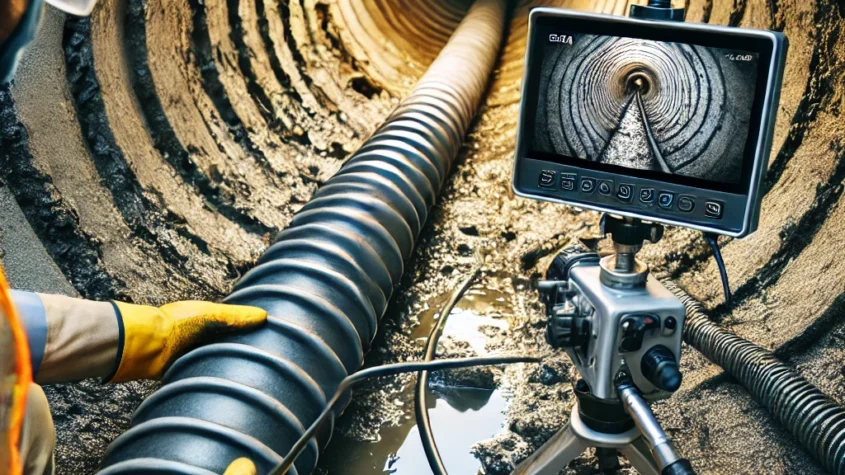
A drain inspection camera is an essential tool for diagnosing plumbing issues without invasive procedures. It allows homeowners and professionals alike to identify blockages, leaks, and pipe damage with precision. This camera can save both time and money by providing real-time visuals of the interior of pipes.
The use of drain inspection cameras has grown significantly in recent years due to their effectiveness. With advanced technology, these cameras can navigate complex plumbing systems and are equipped with high-definition imaging. By highlighting potential problems, they enable informed decision-making regarding repairs or maintenance.
Investing in a drain inspection camera can streamline plumbing inspections and lead to more efficient solutions. This technology not only reveals the condition of pipes but also helps prevent future issues, making it a valuable asset for anyone concerned about their plumbing health.
Essentials of Drain Inspection Cameras
Drain inspection cameras are crucial tools used to assess the condition of underground drainage systems. They provide real-time visual feedback that aids in identifying blockages, damage, and other issues that may affect drainage efficiency.
Components and Functionality
Drain inspection cameras typically consist of several key components. These include a waterproof camera, a flexible cable, and a reel for cable management.
- Waterproof Camera: Designed to withstand harsh conditions, the camera captures high-resolution images and videos, facilitating accurate inspections.
- Flexible Cable: This enables the camera to navigate bends and turns in pipelines, reaching areas that are otherwise inaccessible.
- Light Source: Integrated LED lights illuminate dark spaces within the drain, ensuring clear visuals.
The entire system can connect to a monitor or recording device, allowing users to analyze the findings in real-time or store them for future reference.
Types and Specifications
Different types of drain inspection cameras cater to varying needs. They can be classified based on size, functionality, and specific application.
- Push Cameras: Small and portable, these are suited for residential plumbing inspections. They usually have a shorter range.
- Crawler Cameras: These are larger, equipped with tracks to navigate larger pipes, ideal for commercial applications.
- Wireless Models: They eliminate the need for cables, providing greater flexibility but may be limited by battery life.
Users should consider specifications like camera resolution, cable length, and depth rating when selecting a camera. Higher resolution ensures better image quality, while longer cables allow access to deeper systems.
Optimal Use Cases
Drain inspection cameras serve various purposes across multiple sectors. Their versatility makes them valuable tools in specific situations.
- Home Inspections: Homeowners can use these cameras to identify blockages or integrity issues in residential drainage systems.
- Commercial Applications: Businesses can monitor larger sewage systems for maintenance and compliance purposes.
- Construction and Renovation: Inspecting existing drains before building projects helps prevent future problems.
Regular use of these cameras can help maintain efficient drainage systems, ultimately reducing the risk of serious plumbing issues.
Handling and Maintenance
Proper handling and maintenance of a drain inspection camera ensures longevity and optimal performance. Following specific operating procedures, implementing regular maintenance, and knowing how to troubleshoot common issues are essential practices for users.
Operating Procedures
Before using a drain inspection camera, the operator should familiarize themselves with the user manual. This includes understanding all controls and settings.
Steps to Follow:
- Pre-Inspection Check: Ensure the camera is clean, charged, and in good working condition. Inspect cables for damage.
- Setup: Position the camera at the entry point of the drain and connect any necessary cables.
- Operation: Power on the device and adjust the camera settings based on the inspection requirements.
During operation, avoid sudden movements to prevent damaging the camera. After inspection, turn off the camera and carefully retract it.
Regular Maintenance
Routine maintenance is crucial to extend the lifespan of the drain inspection camera. Schedule maintenance checks to keep it in top condition.
Maintenance Tasks:
- Cleaning: After each use, clean the camera lens and housing with a suitable cleaning solution. Avoid abrasive materials.
- Battery Care: Regularly check and charge the battery. If the camera remains unused for long periods, disconnect the battery to prevent drainage.
- Software Updates: Periodically check for and install any firmware updates to ensure optimal performance.
Establishing a maintenance log can help track these tasks.
Troubleshooting Common Issues
Even with proper handling, users may encounter issues with the drain inspection camera. Knowing how to troubleshoot can save time and reduce frustration.
Common Problems and Solutions:
- No Power: Check the battery charge; if low, recharge. Ensure all connections are secure.
- Blurry Images: This could indicate a dirty lens. Clean the lens using a microfiber cloth.
- Poor Signal Transmission: Inspect the cable for damages or kinks. Replace if necessary.
Keeping a checklist of common issues can facilitate quick resolution during inspections.
Standing Desk Canada: The Benefits and Options for Healthier Workspaces
The rise of remote work has led many individuals in Canada to explore the advantages of st…








